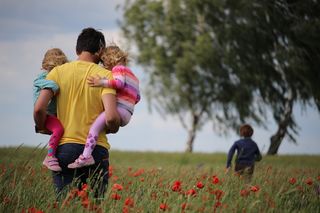Attachment
Harvard Found This to Be the Indisputably Best Way to Parent
It's all about discipline, but probably not the kind you're thinking.
Posted June 23, 2019 Reviewed by Matt Huston

Cumulative bodies of research make it clear: Whomever the child and whatever the issues at hand, the most effective parenting is about discipline, and the kind of discipline called for is primarily–wait for it–disciplined parenting.
This requires not only an incredible dose of humility but also a fullness of perspective. I must confess that in moments of irritability, as a parent and otherwise, I often react impulsively and act at the whim of my own anxiety. I still have a long way to grow. Fortunately, most children are highly resilient and actually will aid significantly in teaching ever-learning parents, if we are sufficiently wise and adaptive to listen well and adjust accordingly.
Every child is unique. We must wrestle to confront realities of temperament, relationship security, and behavioral learning with an eye toward the whole child. Otherwise, we risk seeing only what we have been trained to see or even only what we want to see and, consequently, reducing the child to our own biases, blinded to the whole and missing critical opportunities to meet fundamental needs.
Interactive, Emotional Learning
A child's supportive network of caring individuals becomes the embodiment of what psychologist John Bowlby (1980) called “representational models of attachment figures.” Children who have had a more secure attachment with their parents or other early childhood caregivers are going to, for instance, tend to view their school teacher nearly automatically as “being available, responsive, and helpful and a complementary model of himself as a potentially lovable and valuable person.” This child is likely to be more confident, approachable, and resilient.
But children who have had adverse or negligent relationships with parents or other caregivers are likely to be self-doubting and behave in either more withdrawn or more disruptive ways. Juliet Hopkins (2015) wrote,
"In homes where the baby finds no mutuality, where the parent’s face does not reflect the baby’s experience, and where the child’s spontaneous gesture is not recognized or appreciated, neither trust in others nor confidence in the self develop.”
Either due to traumatic experiences—including abuse or extreme neglect—or neurodiversity, some kids have intense fight, flight, or freeze responses and little ability to self-soothe. Chronic volatility in family relationships can also set this pattern into motion. Developmental neurobiologist Daniel Siegel (2003) wrote, “The mind develops as the brain responds to ongoing experience.” Problem behavior is a manifestation of well-worn neural and cognitive pathways that translate into reflexive emotional, cognitive, and behavior patterns.

In the face of problem behavior, we must learn to detour domino-effect reactions, which so frequently emanate from underlying fear or shame. Matthew Selekman (1993) wrote that change arises “out of the breaking of patterns, both of thought and action, the interruption of repeating sequences.” Many adults perpetuate volatile patterns unintentionally by interacting with children in ways that trigger further volatility. Navigating out of these ruts requires self-control, empathy, and creativity. Explosive and withdrawn behaviors are typically adaptive responses, arising out of needs to be liked, valued, and respected, needs to have some sense of predictability and control, and needs to heighten or lessen sensory stimulation.
Development in the Balance
Developmental and adaptive processes are best supported, and needs best met, through responsive parenting, which the Harvard Family Research Project (2012) defined as "the use of warm and accepting behaviors to respond to children's needs and signals" and concluded is critically important to a young child's development (Landry, Smith, Swank, Zucker, Crawford, & Solari). This was not a new or novel finding. Any deep dive into the literature on child development leaves an even more pronounced impression of the importance of parental responsiveness in the course of nurturing attachment security and empowering developmental exploration.
A child needs firm guidance alongside unconditional acceptance. Parents then must discern that ever fine line between what is vital and what is negotiable. One guiding principle often nudges parents in a wise direction: “Seek first to understand and then to be understood" (Covey, 1990). When a child is angry or anxious, simply feeling heard or understood can be calming and helpful.
Many children carry with them legitimate anger, fear, sadness, and shame related to predispositions, circumstances, and experiences largely out of their control. They need someone to love them in spite of ways they reflexively aggress or distance as they negotiate through ambivalent inclinations. At the end of the day, every child wants and needs to be heard–which is just another way of saying well understood—and loved—which is just another way of saying well known.
Alicia Lieberman and Patricia Van Horn (2008) described an ideal attachment trajectory:
“As the growing baby acquires greater self-regulation skills, a secure attachment is increasingly characterized by a mutuality of adjustments until it becomes a goal-corrected partnership, where mother and child can resolve conflicting individual agendas through give-and-take based on each partner’s empathic awareness of the other’s plans and needs. A mature secure attachment is characterized by reciprocity, defined as the capacity to recognize and adjust to the other’s experience, to repair lapses in empathy, and to restore mutual attunement following conflict. These are the key ingredients of satisfying intimate relationships across a person’s lifetime."
A "mutuality of adjustments." I love that recognition of the systemic nature of the parent-child relationship. Yet ultimately–it goes without saying–it is the parent who is primarily responsible to be the one sufficiently disciplined to make continual and necessary adjustments.
And to be clear, there are not one but two fundamental drives present throughout our lifespan: attachment, the need for closeness to others and a sense of belonging, and autonomy, the need for responsible independence and self-control. We, therefore, have a responsibility in relationships with our children to nurture safe and comfortable closeness (attachment) as well as safe and comfortable distance (autonomy). They are both fundamentally part of the same parenting dance, in which the parent is obviously in the lead.

Over the years, I have heard and even mediated disagreements revolving around whether parents should focus more with children on relationship-building or more on behavior management. This is a false dichotomy. We have the responsibility to satisfy their needs for a safe and secure emotional base, while also setting limits and empowering increasing self-direction and nurturing increasing self-significance. Mature parents nurture both secure attachment and responsible autonomy—often simultaneously.
When problems arise, we all experience anxieties and impulses. Skillful parenting requires exerting appropriate control while acting in loving ways that not only model how but instill courage in our children to act in spite of their own anxieties and impulses. May we all learn and practice well the art of this disciplined balance. It is the indisputably best way to parent.
References
Bowlby J (1980). Loss: Sadness & Depression. Attachment and loss (vol. 3); (International psycho-analytical library no.109). London: Hogarth Press.
Covey, S. (1990). The seven habits of highly effective people. New York, NY: Simon & Schuster.
Hartzell, M., & Siegel, D. (2003). Parenting from the inside out. New York, NY: Tarcher/Penguin.
Hopkins, J., and Horne, A. (2015). An independent mind: Collected papers of Juliet Hopkins. Hoboken: Taylor and Francis.
Landry, S.H., Smith, K. E., Swank, P. R., Zucker, T., Crawford, A. D., & Solari, E. F. (2012). The effects of a responsive parenting intervention on parent–child interactions during shared book reading. Developmental Psychology 48(4):969-86.
Lieberman, A., & Van Horn, P. (2008). Psychotherapy with infants and young children. New York, NY: Guilford Press.
Selekman, M. (1993). Pathways to change: Brief therapy solutions with difficult adolescents. New York: The Guilford Press.




